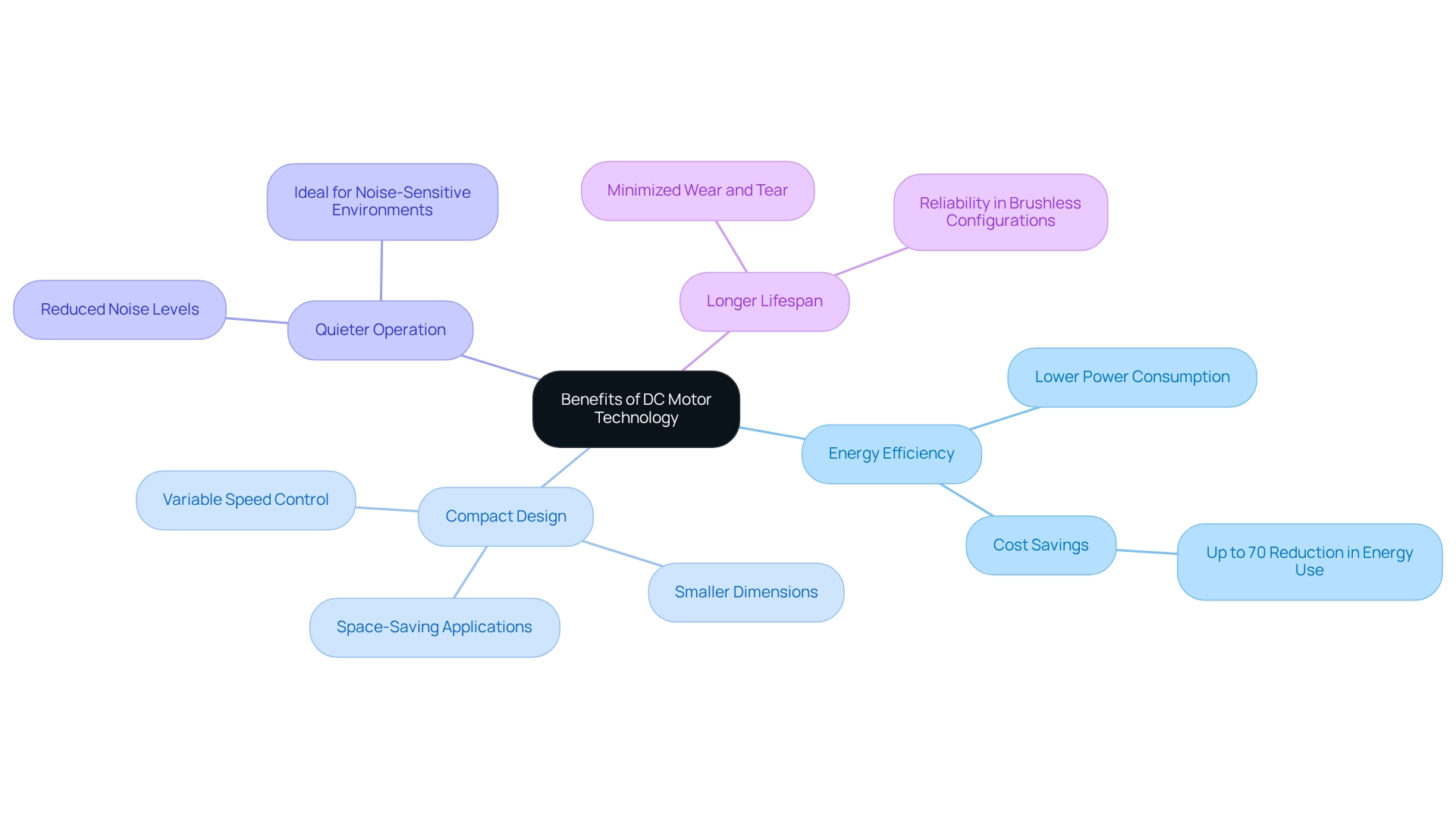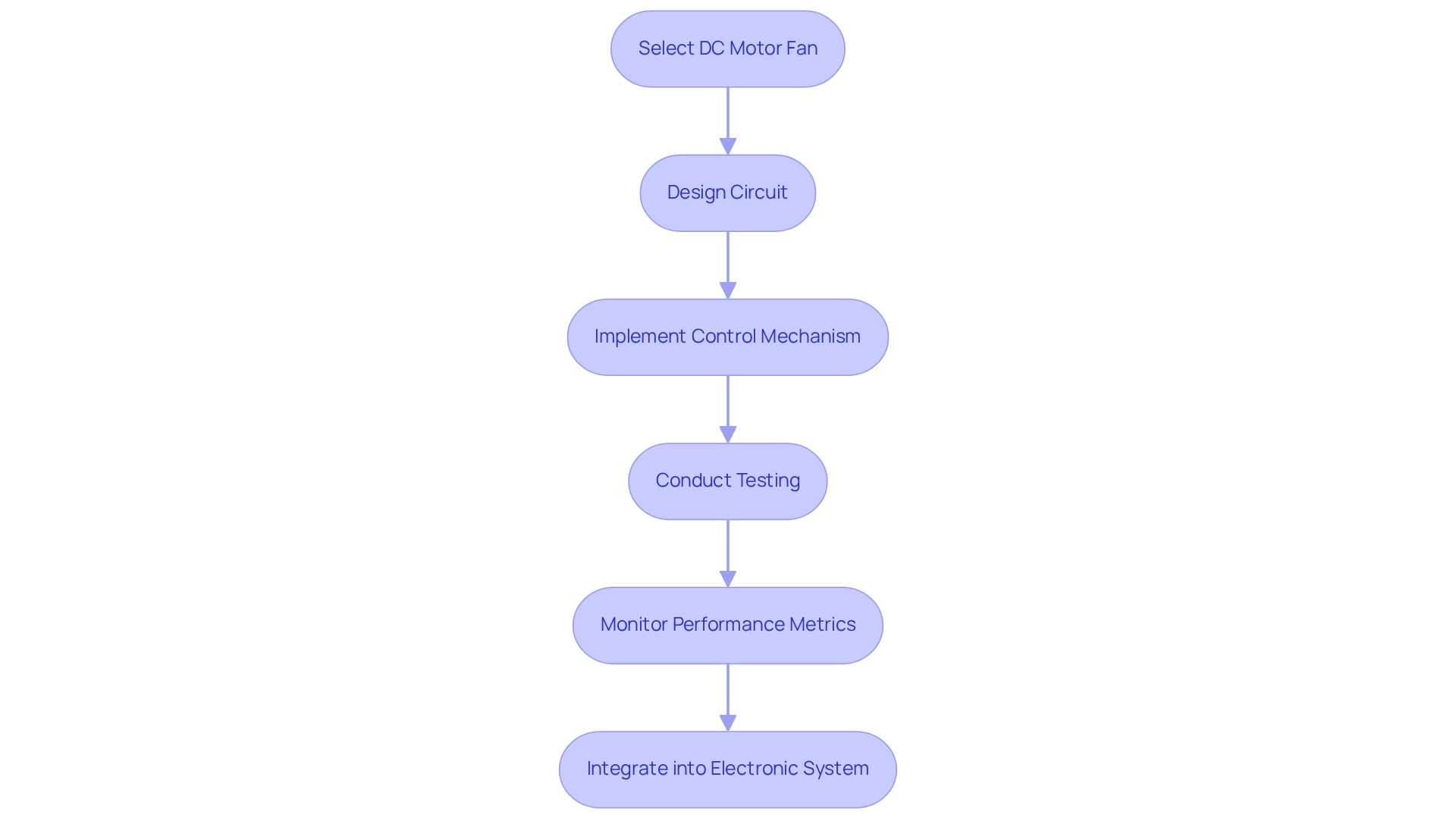Overview
The article examines the integration of DC motor fans within electronic systems, emphasizing their distinct advantages and diverse applications. DC motor fans are recognized for their energy efficiency, compact design, and quieter operation compared to AC fans. These attributes render them suitable for a variety of applications including:
- Electronics cooling
- HVAC systems
- Automotive ventilation
Furthermore, the article provides a systematic approach to their implementation in electronic systems, ensuring that readers can effectively leverage these benefits.
Introduction
In the realm of modern technology, DC motor fans have emerged as essential components across various industries, offering innovative solutions for efficient cooling and ventilation. Unlike their AC counterparts, these fans leverage direct current to deliver superior performance, quieter operation, and impressive energy efficiency. From electronics cooling in computers to HVAC systems and automotive applications, the versatility of DC motor fans is undeniable. As organizations seek to optimize their systems, understanding the myriad benefits and integration methods of DC motor technology becomes crucial for driving performance and sustainability.
Define DC Motor Fans and Their Applications
DC-driven cooling devices operate using direct current (DC) systems, distinguishing themselves from alternating current (AC) devices that rely on a sinusoidal power supply. The steady voltage utilized by DC units powers the motor, resulting in several advantages, such as enhanced efficiency and quieter operation. Gagner-Toomey Associates, recognized as the globe’s largest producer of standard and custom air-movers, offers an extensive range of DC input tube axial units and centrifugal devices. These products are optimized for efficiency and minimal noise, making them ideal for a variety of applications. Available sizes for tube axial fans range from 15 to 280mm, while centrifugal blowers are offered in sizes from 15 to 225mm. Most models can be equipped with IP protection upon request.
Applications of DC Motor Fans:
- Electronics Temperature Management: These fans are commonly employed in computers and other electronic devices to dissipate heat. Gagner-Toomey’s solutions encompass a complete portfolio of DC motor fans and blowers specifically designed for effective electronics temperature management.
- HVAC Systems: They are integral to heating, ventilation, and air conditioning systems, ensuring efficient airflow.
- In automotive applications, DC motor fans facilitate cabin ventilation and regulate engine temperature, with custom designs available to meet specific automotive requirements.
- Industrial Equipment: These devices are incorporated into machinery for temperature regulation and ventilation, ensuring optimal performance in industrial environments.
- Home Appliances: Found in appliances such as refrigerators and microwaves, these fans maintain optimal temperatures, underscoring the versatility of Gagner-Toomey’s cooling solutions.

Explore the Benefits of DC Motor Technology
DC motor technology presents several notable advantages that are essential for modern applications.
- Energy Efficiency: DC machines consume less power compared to their AC counterparts, leading to significant reductions in energy costs. Research indicates that a DC motor fan can decrease energy consumption by as much as 70%, making it a cost-effective choice.
- Compact Design: The smaller dimensions of DC devices allow for the creation of more compact structures, particularly beneficial in environments where space is at a premium, such as with a DC motor fan. The DC motor fan provides variable speed control, allowing for easy adjustment of speeds and greater flexibility in managing airflow to meet specific requirements.
- Quieter Operation: Typically, the design of a DC motor fan results in quieter operation, a critical factor in noise-sensitive environments.
- Longer Lifespan: The DC motor fan generally exhibits a longer operational life due to minimized wear and tear, especially in brushless configurations, ensuring reliability over time.

Implement DC Motor Fans in Electronic Systems
Integrating a dc motor fan into electronic systems requires a systematic approach to ensure optimal performance. Begin by selecting a DC motor fan that aligns with the specifications of your application. Consider critical factors such as size, airflow rate, and voltage to ensure compatibility.
Next, design a circuit that incorporates the dc motor fan, ensuring it is compatible with your power supply. Utilize appropriate components, including resistors and capacitors, to stabilize the circuit and enhance reliability.
Implement a robust control mechanism, such as a PWM (Pulse Width Modulation) controller, to dynamically adjust the speed of the dc motor fan based on temperature or other relevant parameters. This will optimize performance and energy efficiency.
Following assembly, conduct thorough testing of the system to verify that the dc motor fan operates correctly and efficiently. Monitor key performance metrics, including airflow and noise levels, to ensure compliance with your standards.
Finally, integrate the dc motor fan into your overall electronic system, ensuring seamless interaction with other components. This step is crucial for achieving a harmonious operational environment.

Conclusion
The exploration of DC motor fans underscores their pivotal role in enhancing cooling and ventilation across various sectors. By leveraging direct current technology, these fans not only outperform traditional AC fans in energy efficiency but also provide quieter operation and a longer lifespan. Their applications range from electronics cooling in computers to automotive ventilation and HVAC systems, emphasizing their versatility and significance in modern technology.
The advantages of DC motor technology are unmistakable:
- Substantial energy savings
- Compact designs ideal for space-constrained environments
- Capacity for precise fan speed control
This makes them exceptionally suited for both industrial and consumer applications, where efficiency and performance are critical.
Integrating DC motor fans into electronic systems is a straightforward endeavor that involves careful selection, circuit design, and thorough testing to ensure optimal functionality. As industries increasingly prioritize performance and sustainability, the adoption of DC motor fans is poised to expand, further solidifying their status as essential components in the pursuit of innovation and efficiency. Embracing this technology not only enhances operational effectiveness but also contributes to a more sustainable future.
Frequently Asked Questions
What distinguishes DC-driven cooling devices from AC devices?
DC-driven cooling devices operate using direct current (DC) systems, while AC devices rely on alternating current (AC) with a sinusoidal power supply.
What are the advantages of using DC units?
DC units provide enhanced efficiency and quieter operation due to the steady voltage that powers the motor.
Who is Gagner-Toomey Associates and what products do they offer?
Gagner-Toomey Associates is the largest producer of standard and custom air-movers globally, offering a wide range of DC input tube axial units and centrifugal devices optimized for efficiency and minimal noise.
What sizes are available for tube axial fans and centrifugal blowers?
Tube axial fans are available in sizes ranging from 15 to 280mm, while centrifugal blowers are offered in sizes from 15 to 225mm.
Can the fans from Gagner-Toomey be customized?
Yes, most models can be equipped with IP protection upon request.
What are some applications of DC motor fans?
DC motor fans are used in various applications including: 1. Electronics Temperature Management: For dissipating heat in computers and electronic devices. 2. HVAC Systems: Integral for efficient airflow in heating, ventilation, and air conditioning systems. 3. Automotive Applications: For cabin ventilation and regulating engine temperature, with custom designs available. 4. Industrial Equipment: Incorporated into machinery for temperature regulation and ventilation. 5. Home Appliances: Used in appliances like refrigerators and microwaves to maintain optimal temperatures.

